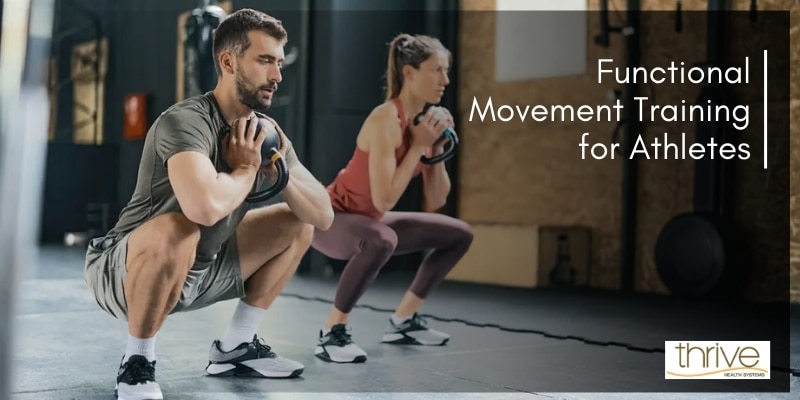
In the competitive world of sports, athletes are constantly seeking ways to gain an edge and maximize their potential. One effective method gaining traction is Functional Movement Training, a comprehensive approach designed to enhance athlete performance and accelerate athlete recovery. This specialized training focuses on improving movement efficiency and overall performance enhancement, which are crucial for excelling in any sport.
Functional training for athletes goes beyond traditional workouts by incorporating exercises that mimic real-life movements and sport-specific actions. This approach not only boosts athlete conditioning but also ensures that training is directly applicable to athletic performance. By focusing on movement patterns and functional exercises, athletes can achieve better results and a more robust recovery process.
Sports training that integrates functional movement principles helps athletes develop the strength, agility, and flexibility needed for peak performance. It emphasizes performance enhancement through improved movement efficiency, which translates into more effective training sessions and a reduced risk of injury.
In this blog, we will explore the numerous benefits of functional movement training for athletes, including how it can enhance performance, support recovery, and contribute to overall athletic success. From understanding the key principles to applying practical techniques, discover how this innovative approach can elevate your training and optimize your results.
1. Understanding Functional Movement Training
Functional Movement Training is a holistic approach that focuses on improving movement patterns and functional strength. It integrates exercises that mimic the natural movements performed in daily activities and sports.
- Definition and Purpose: Functional movement training aims to enhance movement efficiency and overall athlete performance by targeting the fundamental patterns of movement.
- Core Principles: It emphasizes exercises that involve multiple muscle groups and joints, promoting functional fitness.
- Contrast with Traditional Training: Unlike traditional strength training, which often isolates muscle groups, functional training improves coordination and balance, which are crucial for athletic success.
2. Improving Athlete Performance
By focusing on functional movement patterns, athletes can achieve significant improvements in their performance across various sports.
- Enhanced Strength and Agility: Functional training helps athletes develop athlete strength training that taranslates into better agility and power.
- Sport-Specific Skills: Tailoring exercises to the specific demands of a sport improves sports performance training and helps in mastering sport-specific skills.
- Injury Prevention: Improved movement patterns reduce the risk of injuries by enhancing overall movement efficiency and proper technique.
3. Benefits of Functional Training for Athletes
Functional training for athletes provides numerous benefits that support both performance enhancement and recovery.
- Increased Functional Strength: Functional exercises build strength that is directly applicable to athletic movements, improving overall athlete conditioning.
- Better Movement Patterns: Training focuses on functional movement patterns that enhance coordination and balance.
- Enhanced Recovery: Functional training contributes to athlete recovery by promoting better circulation and reducing muscle soreness.
4. Role of Functional Fitness in Athlete Conditioning
Functional fitness is essential for improving athlete conditioning by targeting movements and muscle groups that are used in sports.
- Dynamic Movements: Incorporates exercises that simulate the dynamic movements of sports, enhancing overall performance.
- Comprehensive Conditioning: Focuses on developing strength, flexibility, and endurance through a variety of functional exercises.
- Improved Functional Capacity: Enhances the body’s ability to perform complex movements efficiently and effectively.
5. Performance Enhancement through Movement Efficiency
Optimizing movement efficiency is a key aspect of performance enhancement in athletes.
- Biomechanical Optimization: Functional training improves the biomechanics of movement, leading to more efficient energy use.
- Reduction in Fatigue: Efficient movement patterns reduce unnecessary energy expenditure, which helps in delaying fatigue.
- Improved Speed and Agility: Enhanced movement efficiency translates into faster and more agile performance on the field or court.
6. Functional Movement Patterns and Sports Training
Sports training that includes functional movement patterns offers a more effective approach to improving athletic performance.
- Application to Specific Sports: Exercises are designed to mimic the specific movements of different sports, enhancing relevant skills.
- Incorporation of Multi-Joint Exercises: Focuses on exercises that involve multiple joints and muscles, similar to those used in actual sports scenarios.
- Skill Transfer: Improves the transferability of training results to actual sporting performance, making workouts more relevant and effective.
7. Integrating Recovery Techniques for Athletes
Effective recovery techniques for athletes are essential for optimizing the benefits of functional training and ensuring long-term performance improvements.
- Active Recovery: Incorporates low-intensity exercises that promote blood flow and muscle repair, aiding in quicker recovery.
- Stretching and Mobility Work: Enhances flexibility and reduces muscle stiffness, which supports better movement efficiency.
- Rest and Nutrition: Emphasizes the importance of adequate rest and a balanced diet to support muscle recovery and overall health.
8. Athletic Performance Improvement through Functional Movement
Athletic performance improvement is achieved by incorporating functional movement training into regular practice.
- Enhanced Overall Performance: Functional training helps in improving all aspects of performance, from strength and speed to endurance and flexibility.
- Better Adaptability: Prepares athletes to perform well under varying conditions and situations encountered in their sport.
- Improved Recovery Times: Facilitates quicker recovery from intense training and competition, leading to more consistent performance.
9. Holistic Approach to Athlete Training
A holistic approach to athlete training includes integrating functional movement with other training modalities for comprehensive development.
- Combining Strength and Conditioning: Merges functional training with traditional strength and conditioning to provide a well-rounded training regimen.
- Mental and Physical Integration: Addresses both the physical and mental aspects of training, enhancing overall athlete performance.
- Customization and Personalization: Tailors training programs to individual athletes’ needs, considering their specific sports and performance goals.
10. Future Trends in Functional Movement Training
As functional movement training continues to evolve, new trends and innovations are shaping the future of athlete performance and recovery.
- Technology Integration: Use of advanced technologies such as motion analysis and wearable sensors to track and optimize movement patterns.
- Research and Development: Ongoing research into the effectiveness of functional training methods and their impact on various aspects of athletic performance.
- Customized Training Programs: Increased focus on developing personalized training programs based on individual assessments and goals.
Conclusion
Functional movement training offers a transformative approach to enhancing athlete performance and facilitating athlete recovery. By focusing on functional training for athletes, athletes can improve movement efficiency, develop better functional fitness, and achieve significant performance enhancement. This approach not only boosts athlete conditioning but also ensures that training is both effective and sustainable.
Integrating functional movement patterns into sports training can lead to improved strength, agility, and overall athletic performance. Coupled with effective recovery techniques for athletes, functional training provides a comprehensive solution for optimizing performance and reducing injury risks. As the field of sports training continues to advance, embracing functional movement principles will remain a key factor in achieving athletic success and long-term well-being.

